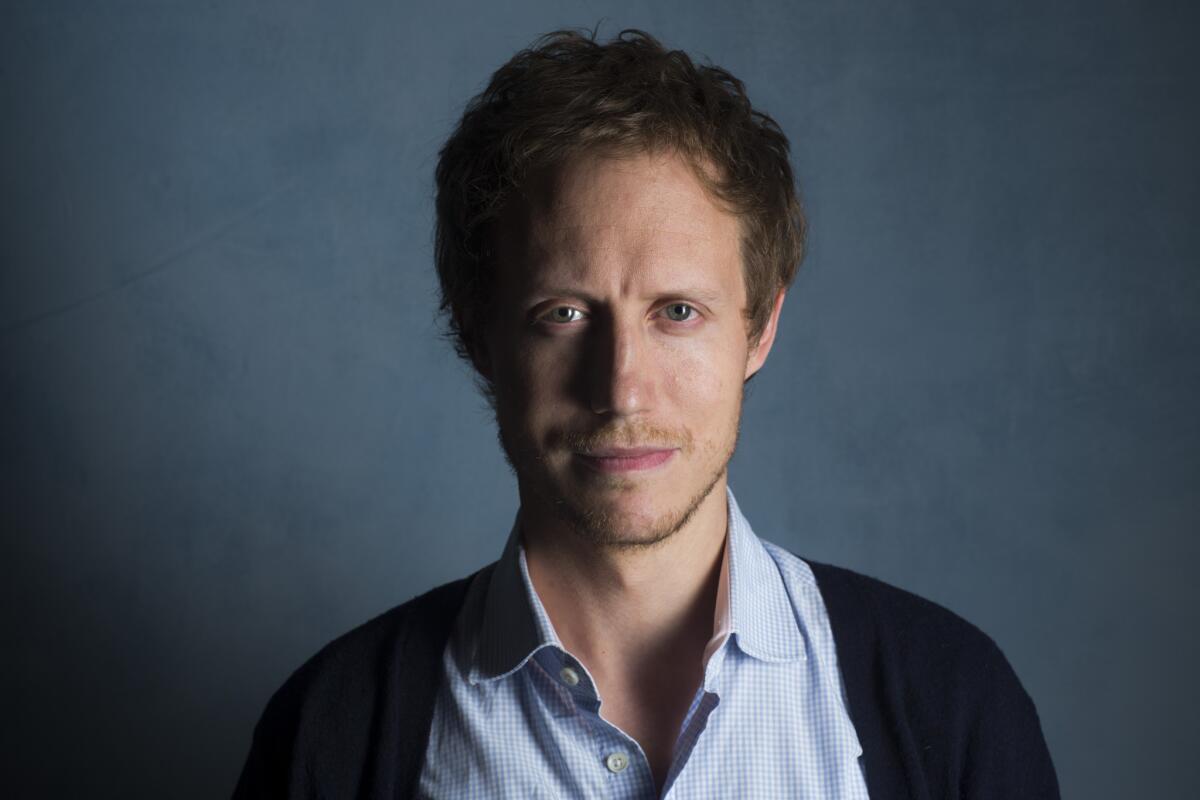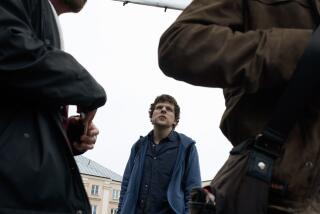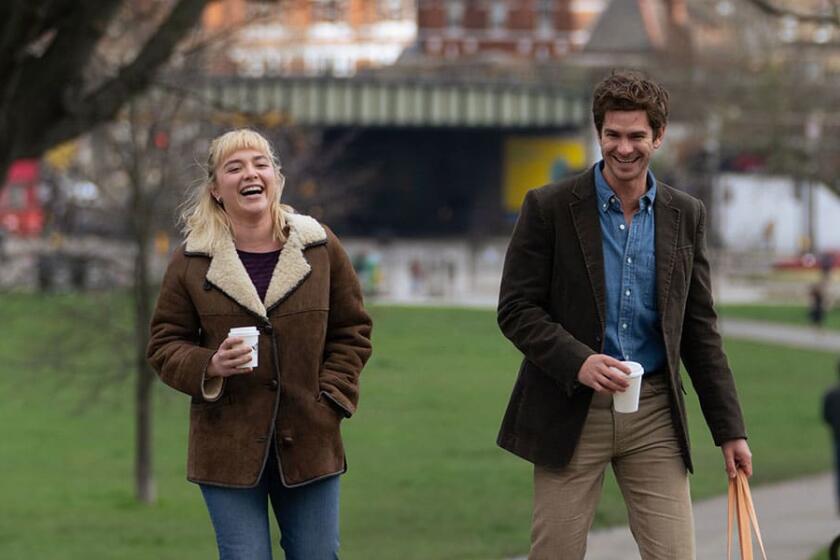Q&A: Director László Nemes on how ‘Son of Saul’ is a Renaissance-style portrait of a Holocaust victim
Reporting from Palm Springs — It is the film that has generated foreign language Oscar buzz since it landed like a meteor on the big screen at the Cannes Film Festival in May. “Son of Saul,” the debut feature from Hungarian director László Nemes has inspired plenty of critical raves for its imaginative treatment of a subject that has been well-covered in film: the Holocaust.
“Son of Saul” follows a single man, Saul Aüslander (thoughtfully played by Géza Rörhig), through Auschwitz during World War II. In fact, it follows him so closely that the viewer sees little else beyond his immediate vicinity — turning the hell of the concentration camps into one man’s deeply visceral experience.
To this singular form, Nemes layers a morally complicated tale: Aüslander is a Sonderkommando, one of the prisoners who herded concentration camp victims to the gas chambers, then incinerated the bodies.
The film received the Grand Prix at Cannes and has been lauded by the National Board of Review, the New York Film Critics Circle and the Los Angeles Film Critics Assn. (Times critic Kenneth Turan described it as “confident” and “audacious.”) It has nabbed a Golden Globe nomination for best foreign film and is currently on the Academy Awards shortlist in that category.

Director László Nemes, photographed in the L.A. Times photo studio at the 40th Toronto International Film Festival in September 2015.
Nemes was in attendance at the Palm Springs International Film Festival to present “Son of Saul,” where it screened Saturday and Sunday. And he’s taking part in a filmmakers conversation Wednesday with other short-listed Oscar directors. He took time to chat at the festival to discuss the ways in which the film draws from the worlds of cinema, art and architecture to tell its devastating story.
“Son of Saul” has drawn attention for sticking the camera on Saul and keeping everything else in shallow focus. How did you arrive at that decision?
I don’t know. The origins are unconscious. I think of “Come and See,” the Russian film from 1985, [which closely follows a single character in war]. It’s very organic. It’s longer shots.
The human face is such a reference. It’s almost like the idea of making a portrait — like the idea of a Renaissance portrait, where in the background, there is perspective, but it’s very narrow. The narrowness is very important because of the subject. It provides context. But the viewer has to use their imagination to [envision] the things around them. So it opens a mental perspective.
This is the thing you forget about the Holocaust — the human face. It becomes mass. I wanted to focus on one man.
The Holocaust often ends up being a story of survival....That’s problematic. The Holocaust was not about survival. Survival was an exception, an accident.
— ‘Son of Saul’ director László Nemes
What made you choose Rörhig as the subject for this portrait?
I don’t know what I saw in him. He’s a whole personality. He has so many layers. But the first layer is that of an ordinary man. That was important to this film. The character is an ordinary man. But there are layers there, and it suggests that he carries something, an inner perspective.
You had some very long takes — two, three and four minutes. How did you choreograph that?
Every shot had to be prepared very meticulously. It was a long process of preparation. And the background had to be prepared as well. We had a director hired to direct the background. We knew the background gave the framework to the main action. If you do a film that takes place in a camp, you have to communicate the rules of the camp to the viewer, and that was all in the background.
With each take, we either had the rhythm right or the scene right or we didn’t have a scene. So it was filmmaking on the edge all the time. We knew we were making a prototype.

I understand that the set for the film wasn’t shot in a sound studio with one-sided sets. Instead, you did it in a warehouse made to look like a crematorium. How did this architecture affect what we see on the screen?
I wanted a real place. I couldn’t recreate an entire crematorium. But I could recreate the levels with existing levels — so that the stairs really went somewhere. I wanted a continuity of spaces. Everything was more or less 360 degrees. My production designer [László Rajk] is a real architect. He is the one who designed the Hungarian exhibition at Auschwitz. He is extremely knowledgeable about these questions, about architecture.
I think this setting affected everyone very deeply. It felt real. The lighting was integrated into the building. You didn’t have the feeling of being in a movie set. And the fact that we had those three-, four-minute shots, they were immersive for everyone on the set. This energy contributed a lot to the energy of the film.
One of the things that comes across from the setting and the story of the Sonderkommando is the industrial nature of the extermination machine that the Nazis were running.
It was a factory. That’s something that we tend to forget. How real and ordinary, in a way, it was. It was a factory. It just happened to be a factory of death. When people arrived to Auschwitz and were told to go to a building, they didn’t necessarily think of hell. It was just an ordinary building — that was also hell.
We wanted to keep it on the level of everyday life. In films, it has been communicated like it’s on another planet, but it can be here and now. It can be any warehouse building.
Did you watch a lot feature films about the Holocaust to prepare for this?
Yes, it’s years of thinking. I mainly watched [the documentary] “Shoah” as reference. But we did a film that is in conflict with the representations that are often shown in fiction. The fiction films have established a set of codes about how the Holocaust is handled.
You have to have a bad German and a good German. You have to have distance. There has to be the possibility for the audience to be remote and distanced from the events. You have an encompassing view, the big picture. But who could have the big picture apart from a Nazi soldier? The Holocaust often ends up being a story of survival. There is always survival coded into them. That’s problematic. The Holocaust was not about survival. Survival was an exception, an accident.
Then you have all kinds of iconographic traditions. You have to have the obligatory Nazi flag and the Nazi salute. [In these movies], the evil is there — you can isolate it. But in reality, evil is all around. You cannot pinpoint it, you cannot isolate it. When it is everywhere, it becomes something much harder to cope with. Cinema has been very effective in isolating evil, but I wanted to create a diffused world of evil — one that is, in a way, very ordinary, that’s much closer to the truth.
What’s next?
I have a feature about a young woman before the First World War in Hungary. It’s a dark fairy tale. It’s still in development — I’m writing it. But my plan is to work with the same team. I will shoot it in Hungary, in Budapest.
“Son of Saul” is currently screening in Los Angeles at the Nuart Theatre, 11272 Santa Monica Blvd., Sawtelle, Los Angeles, landmarktheatres.com/nuart-theatre.
Nemes will take part in “Talking Pictures: Oscar-Shortlisted Foreign Filmmakers in Conversation,” Wednesday at 6 p.m. at the Palm Canyon Theatre. 538 N. Palm Canyon Drive, Palm Springs. The Palm Springs International Film Festival runs through Sunday in locations around Palm Springs, psfilmfest.org.
Find me on Twitter @cmonstah.
More to Read
Only good movies
Get the Indie Focus newsletter, Mark Olsen's weekly guide to the world of cinema.
You may occasionally receive promotional content from the Los Angeles Times.











